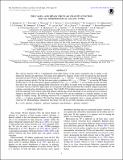THE CALIFA AND HIPASS CIRCULAR VELOCITY FUNCTION FOR ALL MORPHOLOGICAL GALAXY TYPES
Author(s)
Bekeraitė, S.; Walcher, C. J.; Wisotzki, L.; Croton, D. J.; Falcón-Barroso, J.; Lyubenova, M.; Obreschkow, D.; Sánchez, S. F.; Spekkens, K.; Torrey, P.; Ven, G. van de; Zwaan, M. A.; Ascasibar, Y.; Bland-Hawthorn, J.; Delgado, R. González; Husemann, B.; Marino, R. A.; Ziegler, B.; Vogelsberger, Mark; ... Show more Show less
DownloadBekeraitė_2016_ApJL_827_L36.pdf (8.566Mb)
PUBLISHER_POLICY
Publisher Policy
Article is made available in accordance with the publisher's policy and may be subject to US copyright law. Please refer to the publisher's site for terms of use.
Terms of use
Metadata
Show full item recordAbstract
The velocity function (VF) is a fundamental observable statistic of the galaxy population that is similar to the luminosity function in importance, but much more difficult to measure. In this work we present the first directly measured circular VF that is representative between 60 > v[subscript circ] > 320 km s[superscript -1] for galaxies of all morphological types at a given rotation velocity. For the low-mass galaxy population (60 > v[subscript circ] > 170 km s[superscript -1]), we use the HI Parkes All Sky Survey VF. For the massive galaxy population (170 > v[subscript circ] > 320 km s[superscript -1]), we use stellar circular velocities from the Calar Alto Legacy Integral Field Area Survey (CALIFA). In earlier work we obtained the measurements of circular velocity at the 80% light radius for 226 galaxies and demonstrated that the CALIFA sample can produce volume-corrected galaxy distribution functions. The CALIFA VF includes homogeneous velocity measurements of both late and early-type rotation-supported galaxies and has the crucial advantage of not missing gas-poor massive ellipticals that HI surveys are blind to. We show that both VFs can be combined in a seamless manner, as their ranges of validity overlap. The resulting observed VF is compared to VFs derived from cosmological simulations of the z = 0 galaxy population. We find that dark-matter-only simulations show a strong mismatch with the observed VF. Hydrodynamic simulations fare better, but still do not fully reproduce observations.
Date issued
2016-08Department
Massachusetts Institute of Technology. Department of Physics; MIT Kavli Institute for Astrophysics and Space ResearchJournal
The Astrophysical Journal
Publisher
American Astronomical Society
Citation
Bekeraitė, S., et al. “THE CALIFA AND HIPASS CIRCULAR VELOCITY FUNCTION FOR ALL MORPHOLOGICAL GALAXY TYPES.” The Astrophysical Journal, vol. 827, no. 2, Aug. 2016, p. L36. © 2016 The American Astronomical Society
Version: Final published version
ISSN
2041-8213
2041-8205